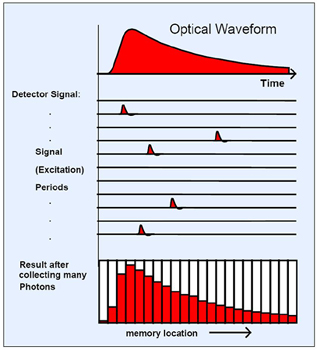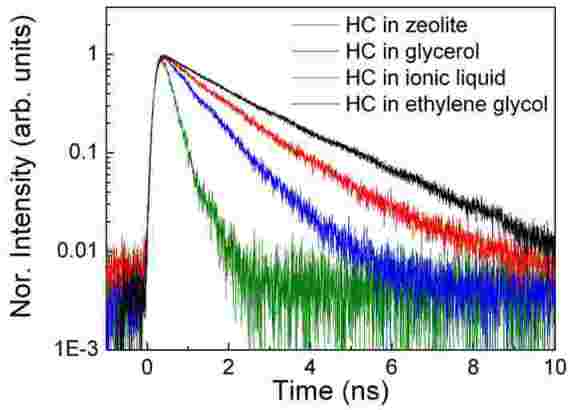Time Correlated Single Photon Counting
From SMOSwiki
(Created page with "'''T'''ime '''C'''orrelated '''S'''ingle '''P'''hoton '''C'''ounting ('''TCSPC''') has been one of the best ways of measuring fluorescence decay times since the method was concei…")
Latest revision as of 13:50, 30 December 2010
Time Correlated Single Photon Counting (TCSPC) has been one of the best ways of measuring fluorescence decay times since the method was conceived in 1961 by Bollinger and Thomas [1]. The principle of time correlated single photon counting is the detection of single photons and the measurement of their arrival times in respect to a reference signal, usually the light source. This technique is a statical method and high repetitive light source is needed to accumulate a sufficient number of photon events for a required statistical data precision [2]. The important features of the method are high sensitivity and accuracy with picosecond time resolution.
Typical applications :
Fluorescence Lifetime Measurements
Detection and Identification of Single Molecules
DNA Sequencing
Optical Tomogrphy
Fluorescence Lifetime Imaging
The method has some striking benefits :
Ultra-High time Resolution ~25ps fwhm with the best detectors
Ultra-High Sensitivity-down to the Single Photon Level
Short Measurement Times
High Dynamic Range-Limited by Photon Statistics only
Excellent Signal-to-Noise Ratio
Measurement Principle
Time-Correlated Single Photon Counting is based on the detection of single Photons of periodical light signal, the measurement of the detection times of the individual photons and the reconstruction of the waveform from the individual time measurements. The method makes use of the fact that for low level, high repetition rate signals the light intensity is usually so low that the probability of detection one photon in one signal period is much less than one. Therefore, the detection of several photons can be neglected and the principle shown in the figure below can be used: The detector signal consists of a train of randomly distributed pulses due to the detection of the individual photons. There are many signal periods without photons, other signal periods contain one photon pulse. Periods with more than one photons are very rare. When a photon is detected, the time of the corresponding detector pulse is measured. The events are collected in memory by adding a '1' in a memory location with an address proportional to the detection time. After many photons the histogram of the detection times, i.e. the waveform of the optical pulse, builds up in the memeory. Although this principle looks complicated at the first glimpse, it is very efficient and accurate for the following reasons: The accuracy of the time measurement is not limited by the width of the detector pulse. Thus, the time resolution is much better then with the same detector used in front of an oscilloscope or another linear signal acquisition devicee. Furthermore, all detected photons contribute to the result of the measurement.
Example of the fluorescence decay of the Hemicyanine in ethylene glycol, ionic liquid, glycerol, and zeolite.
[1] Bollinger and Thomas, Rev. Sci. instrum. 32, 1044 (1961)
[2] D.V.O' Connor and D. Phillips, "Time-Correlated Single Photon Conting", Academic Press, London, 1984.


